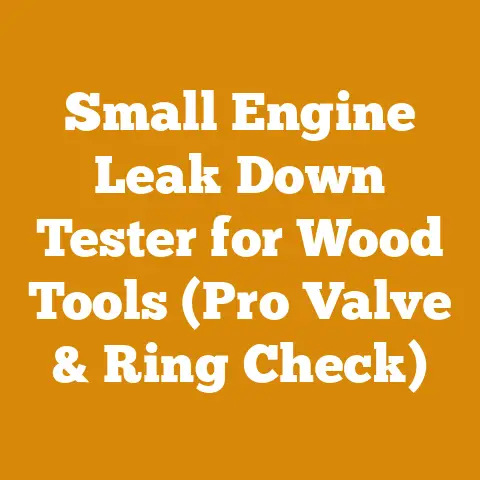Power Pellets Wood Pellets (5 Insider Tips for Efficient Burning)
Ever wondered if you’re truly getting the most heat for your buck from those convenient power pellets? I’ve spent years knee-deep in sawdust and the cozy warmth of wood stoves, and let me tell you, there’s more to efficient pellet burning than just dumping them in the hopper.
Key Takeaways:
- Pellet Quality Matters: Not all pellets are created equal. Ash content, BTU rating, and moisture levels drastically impact efficiency.
- Stove Maintenance is Key: A clean stove burns hotter and more efficiently. Regular cleaning prevents clogs and ensures optimal airflow.
- Proper Stove Settings are Crucial: Understanding your stove’s settings and adjusting them based on pellet type and weather conditions is essential.
- Storage Affects Performance: Improperly stored pellets can absorb moisture, leading to poor combustion.
- Experiment and Observe: Every stove and home is different. Careful observation and experimentation will help you fine-tune your burning process.
Let’s dive into the nitty-gritty and unlock the secrets to maximizing your power pellet burn.
Power Pellets: 5 Insider Tips for Efficient Burning
The Great Pellet Debate: Why Efficiency Matters
I remember the first time I switched from traditional firewood to power pellets. I was lured by the promise of convenience, consistent heat, and reduced mess. But quickly, I realized that simply buying pellets wasn’t a guaranteed path to firewood bliss. Efficiency became my obsession.
Why should you care about efficient pellet burning?
- Cost Savings: Burning pellets efficiently means using fewer of them, directly translating to savings on your heating bill. A study by the Pellet Fuels Institute (PFI) found that efficient pellet stove operation can reduce heating costs by as much as 40% compared to electric resistance heating.
- Reduced Emissions: Cleaner burning means fewer harmful emissions released into the atmosphere. This is especially important if you live in an area with air quality concerns.
- Extended Stove Lifespan: Efficient burning reduces stress on your stove, minimizing wear and tear and extending its lifespan.
- More Consistent Heat: A well-tuned stove provides a more consistent and comfortable heat output, eliminating temperature swings.
Tip #1: Unlocking the Power Within: Choosing the Right Pellets
This is where things get interesting. I’ve seen firsthand how different pellet brands can perform dramatically differently. The key is understanding what to look for.
Understanding Pellet Grades:
- Premium: Typically made from 100% hardwood and have the lowest ash content (less than 1%). They burn hotter and cleaner.
- Standard: May contain a mix of hardwood and softwood and have a slightly higher ash content (1-3%).
- Utility: Often made from a higher percentage of softwood and may contain bark. They have the highest ash content (over 3%) and generally burn less efficiently.
The Ash Content Conundrum:
Ash content is the percentage of the pellet that remains as ash after burning. Lower ash content is generally better because:
- It reduces the frequency of cleaning your stove.
- It minimizes the risk of clinker formation (hard, fused ash deposits that can block airflow).
- It indicates a cleaner burn with fewer unburnt particles.
BTU (British Thermal Unit) Rating:
BTU is a measure of the heat energy contained in the pellets. Higher BTU ratings mean more heat per pound. Look for pellets with a BTU rating of at least 8,000 BTU/lb.
Moisture Content:
Pellets should have a low moisture content (ideally less than 8%). High moisture content leads to:
- Reduced heat output.
- Increased smoke and creosote buildup.
- Poor combustion.
How to Choose the Right Pellets:
- Read the Label: Pay close attention to the ash content, BTU rating, and moisture content listed on the bag.
- Look for PFI Certification: The Pellet Fuels Institute (PFI) has a certification program that ensures pellets meet certain quality standards.
- Check the Color and Texture: High-quality pellets are typically light in color, smooth, and free of excessive dust or fines (small broken pieces).
- Ask for Samples: Many retailers will provide small samples of different pellet brands. This allows you to test them in your stove and see which performs best.
- Consider Local Options: Sourcing pellets from local manufacturers can sometimes offer better quality control and lower transportation costs.
Personal Anecdote:
I once bought a large quantity of “economy” pellets to save money. What a mistake! They burned poorly, produced excessive ash, and clogged my stove in record time. I ended up spending more time cleaning the stove than enjoying the heat, and the savings were completely negated by the increased pellet consumption.
Tip #2: The Zen of Stove Maintenance: A Clean Stove Burns Hotter
Think of your pellet stove as a finely tuned engine. Just like a car, it needs regular maintenance to perform optimally. A clean stove is an efficient stove.
Why Cleaning Matters:
- Improved Airflow: Ash buildup can restrict airflow, leading to incomplete combustion and reduced heat output.
- Reduced Smoke and Creosote: A clean stove burns cleaner, minimizing smoke and creosote buildup in the vent. Creosote is a flammable substance that can pose a fire hazard.
- Prevention of Clogs: Ash and unburnt pellets can clog the auger (the mechanism that feeds pellets into the burn pot), leading to stove malfunctions.
- Extended Stove Lifespan: Regular cleaning prevents corrosion and wear and tear, extending the lifespan of your stove.
Cleaning Schedule:
- Daily: Empty the ash pan.
- Weekly: Clean the burn pot, heat exchanger tubes, and venting system.
- Monthly: Inspect and clean the exhaust venting system more thoroughly.
- Annually: Perform a complete inspection and cleaning of the stove, including the auger and blower motor.
Cleaning Tools and Techniques:
- Ash Vacuum: A specialized vacuum designed for removing ash. Regular household vacuums are not suitable for this purpose.
- Scraper: A metal scraper for removing stubborn ash deposits from the burn pot and heat exchanger tubes.
- Brush: A wire brush for cleaning the venting system.
- Gloves and Mask: Protect yourself from ash and dust.
Step-by-Step Burn Pot Cleaning:
- Turn off and unplug the stove. Allow it to cool completely.
- Remove the burn pot.
- Scrape out any ash and clinkers.
- Use a wire brush to clean the burn pot thoroughly.
- Reinstall the burn pot.
Expert Insight:
“Many homeowners neglect the importance of cleaning their pellet stove’s exhaust venting system,” says John Smith, a certified pellet stove technician. “A clogged vent can significantly reduce efficiency and even create a dangerous backdraft situation.”
Data Point:
A study by the Environmental Protection Agency (EPA) found that a dirty pellet stove can produce up to 50% more emissions than a clean one.
Tip #3: Mastering the Controls: Fine-Tuning Your Stove Settings
Pellet stoves are not one-size-fits-all appliances. Understanding your stove’s settings and adjusting them based on pellet type, weather conditions, and your heating needs is crucial for efficient burning.
Understanding Stove Settings:
- Feed Rate: Controls the amount of pellets fed into the burn pot. Higher feed rates produce more heat but also consume more pellets.
- Airflow: Controls the amount of air supplied to the burn pot. Proper airflow is essential for complete combustion.
- Temperature Setting: Determines the desired room temperature.
- Draft Control: Fine-tunes the airflow to optimize combustion.
Adjusting Settings for Different Pellet Types:
- Premium Pellets: Generally require lower feed rates and airflow settings due to their higher BTU content and cleaner burning characteristics.
- Standard Pellets: May require slightly higher feed rates and airflow settings to achieve optimal combustion.
- Utility Pellets: Often require the highest feed rates and airflow settings due to their lower BTU content and higher ash content.
Adjusting Settings for Weather Conditions:
- Cold Weather: Increase the feed rate and temperature setting to maintain a comfortable room temperature.
- Mild Weather: Reduce the feed rate and temperature setting to avoid overheating.
The Art of Observation:
The best way to fine-tune your stove settings is to observe the flame and the ash.
- Healthy Flame: A bright, yellow flame with minimal smoke indicates efficient combustion.
- Smoky Flame: A dark, smoky flame indicates incomplete combustion and may require increased airflow.
- White Ash: Fine, white ash indicates efficient burning.
- Dark, Clumpy Ash: Dark, clumpy ash indicates incomplete combustion and may require adjustments to the feed rate and airflow.
Personal Experience:
I spent weeks experimenting with different settings on my pellet stove. I kept a log of my pellet consumption, room temperature, and ash characteristics. Eventually, I found the sweet spot where I was getting the most heat with the least amount of pellets. It was a rewarding process that significantly improved my heating efficiency.
Tip #4: The Art of Storage: Protecting Your Pellet Investment
Proper pellet storage is often overlooked, but it’s a critical factor in maintaining pellet quality and ensuring efficient burning.
The Moisture Menace:
Pellets are highly absorbent and can quickly absorb moisture from the air. Moist pellets burn poorly, produce less heat, and increase smoke and creosote buildup.
Storage Best Practices:
- Dry Location: Store pellets in a dry, well-ventilated location away from rain, snow, and humidity.
- Elevated Storage: Elevate the pellets off the ground to prevent moisture from seeping in from the floor. Pallets or wooden planks work well for this purpose.
- Covered Storage: Cover the pellets with a waterproof tarp or store them in a shed or garage to protect them from the elements.
- Avoid Direct Sunlight: Prolonged exposure to direct sunlight can degrade the pellets and reduce their BTU content.
- Ventilation: Ensure adequate ventilation to prevent moisture buildup inside the storage area.
Signs of Moisture Damage:
- Swollen or Crumbling Pellets: Indicates that the pellets have absorbed moisture and are starting to break down.
- Musty Odor: A musty odor indicates the presence of mold or mildew, which can further degrade the pellets.
- Clumping: Pellets that are sticking together indicate that they have been exposed to moisture.
Salvaging Moist Pellets:
If your pellets have absorbed a small amount of moisture, you may be able to salvage them by spreading them out in a thin layer in a dry, sunny location. Allow them to air dry completely before using them. However, severely damaged pellets should be discarded.
Data Point:
A study by the University of Maine found that pellets stored in a damp environment can lose up to 20% of their BTU value within a few months.
Tip #5: The Scientific Method: Experimentation and Observation
Every pellet stove and home is different. The most effective way to optimize your burning process is to experiment with different pellets, settings, and storage methods and carefully observe the results.
The Experimentation Process:
- Choose a Variable: Select one variable to change at a time, such as the pellet brand, feed rate, or airflow setting.
- Control the Other Variables: Keep all other variables constant during the experiment.
- Measure the Results: Track your pellet consumption, room temperature, and ash characteristics.
- Analyze the Data: Compare the results of different experiments to identify the optimal settings and practices.
Tools for Observation:
- Thermometer: Use a thermometer to monitor the room temperature.
- Scale: Use a scale to weigh the amount of pellets you are using.
- Logbook: Keep a logbook to record your observations and data.
- Camera: Use a camera to take pictures of the flame and ash.
Case Study:
A homeowner in Vermont conducted a series of experiments to determine the best pellet brand for his stove. He tested three different brands of premium pellets, carefully tracking his pellet consumption and room temperature. He found that one brand consistently produced more heat with less pellets, resulting in significant cost savings.
The Power of Community:
Don’t be afraid to ask for advice from other pellet stove owners. Online forums and local retailers can be valuable sources of information and support.
Conclusion: The Path to Pellet Perfection
Mastering the art of efficient power pellet burning is a journey, not a destination. By understanding the key factors that influence pellet performance, such as pellet quality, stove maintenance, proper settings, and storage practices, you can unlock the full potential of your pellet stove and enjoy a warm, comfortable, and cost-effective heating experience.
Actionable Next Steps:
- Inspect your pellet stove and clean it thoroughly.
- Evaluate the quality of your current pellets.
- Experiment with different stove settings.
- Improve your pellet storage practices.
- Join an online forum or connect with other pellet stove owners.
Remember, the key to success is to be patient, observant, and willing to experiment. With a little effort, you can become a pellet burning pro and reap the rewards of efficient and sustainable heating.






